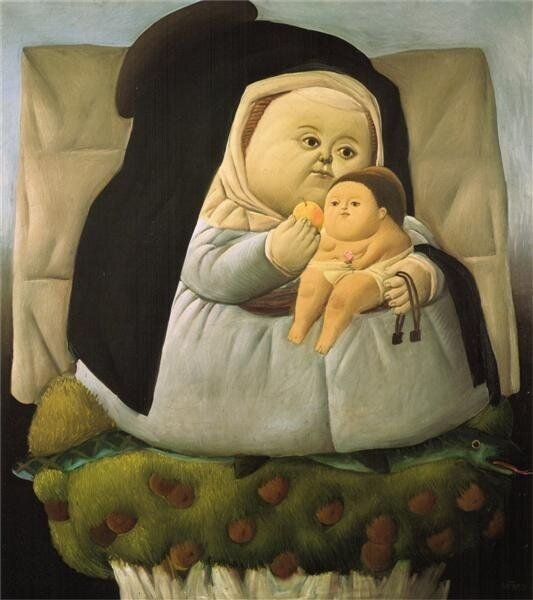Deformation as Reformation: Fernando Botero
Column I
By Anna Calder
When people think about cultural cities, filled with art, architecture and history, many turn to Florence. You only have to go to the Uffizi to marvel at the wonderful paintings and sculptures which adorn the city. However, having visited myself, I have to say that there are only so many times that you can walk by a Madonna and Child and pretend to be interested. Some may see this as an example of how uncultured I am, but I prefer to see it as someone finally telling the truth.
Imagine my glee, then, when I walked into the Museo de Antioquia in Medellín and saw what at first glance was a fat Mary and Jesus. Voluptuous, curvaceous and naturally, quite surprising. The playful take on the image I’d seen a million times over in Florence completely baffled me and left me thinking, who could have the audacity to alter this iconic depiction?
Madonna with Child (1965). Source: Madonna with Child, 1965 - Fernando Botero - WikiArt.org
The answer to this question was Fernando Botero. Born in 1932 in Medellín, Colombia, Botero had his first exhibition in his early twenties. Inspired by a plethora of artists ranging from Velázquez, Rothko and Picasso, Botero refused to be categorised into one particular art school. Neither baroque, as was most popular in Colombia, nor abstract, the movement which was prominent whilst he lived in New York, Botero created his own style.
His unusual take on canonical images led to great success and paved the way for his status as an iconic Latin American artist, placing him on the same pedestal as the likes of Gabriel García Márquez. One of my favourites among his work is his 1978 Mona Lisa, a painting which satirises da Vinci’s classic and deforms the Giaconda into what can only be described as a classical depiction of humpty-dumpty.
Mona Lisa (1978). Source: Fernando Botero's Mona Lisa - Everything you should know (publicdelivery.org)
Although one would assume the focus of his art to be ‘fat people’ with a view to encourage body positivity and inclusivity, Botero rejects this interpretation. He prefers to label his painting style as ‘deformation as a formal principle’. In other words, he manipulates and exaggerates every human, animal and object with the aim of enhancing their sensuous quality. By enlarging his subjects, he allows himself a bigger canvas to explore the intricacies and beauty of the human form. As such, his work is never lacking, but in excess. Botero’s paintings are imbued with a sense of vibrancy and abundance which whilst impressive, are not meant to be realistic.
In this sense, perhaps his decision to depict larger people is reflective of Latin American vernacular. When spending time on the continent, I was surprised by the nonchalance with which people would shout to their friends ‘ay gordito pásame el sal’ or immediately use the term ‘gordo’ when meeting a stranger. Rather than causing offence, as such a term might in England, it connotes a sense of good nature and a loving gesture. Being larger is quite literally synonymous with being larger than life.
Perhaps this has also translated into a spreading of Latin American beauty ideals throughout the world. Hispanic celebrities like JLO and Karol G have triggered a new trend with their globally envied curves, and perceptions of ‘beauty’ are experiencing a worldwide shift.
Whilst there is a lot to be said about the true meaning and influence of Botero’s paintings, there are, like with most artists, no real answers. The only certainty is that even if his work isn’t supposed to be of ‘fat people’, it doesn’t stop the tourists queuing up in Plaza Botero to get a snap of them squeezing the shapely behinds of his sculptures.


